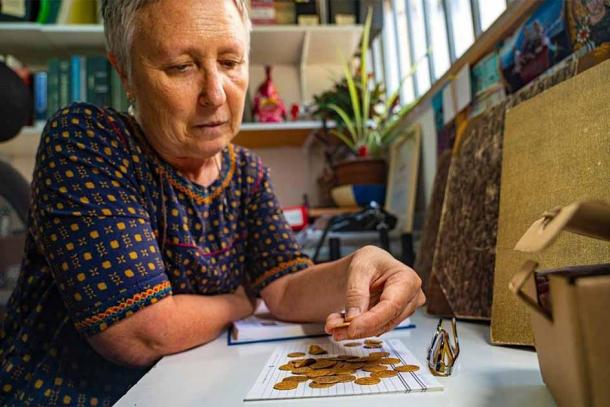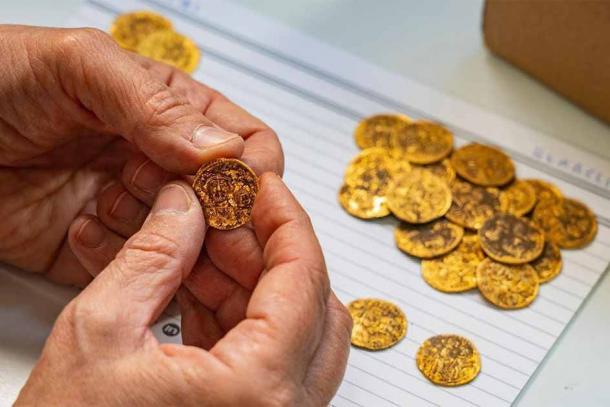
Gold Coin Hoard in Israel Tells the Violent Story of Muslim Conquest
Stashed in a wall in Israel around the time of the Muslim conquest of Jerusalem 1,400 years ago, this gold coin hoard was minted during one of the bloodiest and paradigm changing periods of history.
When interpreted in historic context, these 44 gold coins tell a relentless story of hyper-violent territorial wars in what is now the Middle East. But before those tales are told let’s learn a little about where the hoard was found.
Gold Coin Hoard from Pan’s Labyrinth
The 44 gold coins were discovered in a wall at the archaeological site and ancient city of Banias. Located within Banias Nature Reserve in the eastern Upper Golan Heights, where the Hula Valley meets the Golan at the foot of Mount Hermon, the first settlement at this site was established by Canaanites around 198 BC.
- Explorers find Hidden Treasure in Cave – Coins and Jewelry Dating to Alexander the Great
- Rare Byzantine Coins and Gold Uncovered in Ancient Garbage Pit
By the 3rd century BC the Roman cult of Paneas had taken control of the city and the entire Banias region. In 20 BC King Herod ordered the construction of a vast marble temple at Banias and in 3 BC Herod's son Philip built the first city proper, naming it Cesaria Paneas. Built around a natural spring the name Banias was derived from the Greek God Paneas (Pan), who in Roman mythology and religion protected water sources.
So strategically important was this site to ancient trade and warfare that during the 12th century European Crusaders strategically built the Qal'at al-Subayba fortress above the city of Banias, which represents one of the largest medieval fortresses ever built in the Middle East.

Stash of 44 gold coins found in a wall at the archaeological site and ancient city of Banias in Israel. (Israel Antiquities Authority)
Gold Coin Hoard Quickly Stashed and Left Untouched for 1,400 Years
The Israel Antiquities Authority (IAA) announced on Monday that the 44 gold coins were found in a wall during recent excavations. Professor Yoav Lerer, director of the excavation for IAA, told The Jerusalem Post that the gold coin hoard weighs around 170 grams (6 oz).
Some of the gold coins have been dated to the reigns of Emperor Phocas (602–610 AD) and Emperor Heraclius (610-641 AD). The latter ruled the Eastern Roman Empire during the 635 AD Muslim conquest of Byzantine Palestine and he was also a contemporary of the Prophet Muhammad.
Professor Lerer suggested the treasure was “buried in haste.” While the coin’s owner was “less fortunate,” and failed to return, the gold coins survived almost 1,400 years. Professor Eli Escusido, director of the IAA, said the coin hoard is “an extremely significant” archaeological find because it dates to an important transitional period in both the history of Banias and the entire region of the Levant.

The gold coin hoard discovered at the Banias archaeological site being examined by coin expert Gabriela Bijovsky. (Yaniv Berman / Israel Antiquities Authority)
Tracking Paradigm Changing Transitions
When the gold coins were minted in the 7th century the Byzantine Empire was experiencing the absolute height of its regional power, and also its collapse and dissolution. From their lofty palaces, Byzantine rulers witnessed the emergence of Islam and they fought with tooth and nail resisting its culture changing impact across their Empire. But before the Muslim conquest of the Middle East, the Eastern Roman emperor, Heraclius, was already soaked in Persian Sassanian blood.
One of the most cited wars of this Pre-Muslim period was the Battle of Nineveh in modern Iraq. In December 627 AD, after a 20-year-long conflict, King Khosrow II had captured much of Byzantium’s eastern territories. Heraclius was recorded fighting alongside his soldiers when they smashed the main Sassanian army and famously recovered what were believed to be fragments of the True Cross of Christ. And it was from Cesaria Paneas (Banias) that Heraclius sent the religious relic back to Constantinople.
- Teenagers Find Hoard of Islamic Gold Coins in Israel
- Priceless Gold Coins Discovered in Ancient ‘Piggy Bank’ in Israel

The Banias gold coin hoard included a coin minted by the Byzantine Emperor Heraclius. (Dafna Gazit / Israel Antiquities Authority)
How The Mighty Crumbled
The 44 gold coins were minted before, during and after the death of Mohammed in 632 AD. At this time the four caliphs, or successors, calculated that after the Byzantine-Sassanian wars both enemies were exhausted, so they attacked the Mediterranean. The Byzantine Army was finally defeated in 636 AD at the Battle of Yarmouk and later that year, with their numbers also decimated, the Sassanians were defeated at the Battle of al-Qadisiyyah.
Only three years later, in 636 AD, Byzantium Jerusalem fell to Muslim forces and Egypt followed in 642 AD, with the entire southern Mediterranean coast (today Libya and Tunisia) falling under Muslim control thereafter. In historic value alone, these 44 gold coins are unarguably priceless as they were tucked away for safety on the event of the Muslim conquest of the Holy Land, which entirely changed the future of the Middle East and laid out territorial boundaries that are still fought over today.
Top image: One of the coins found in the gold coin hoard at the Banias archaeological site depicted the image of the Emperor Heraclius and his son. Source: Yaniv Berman / Israel Antiquities Authority
By Ashley Cowie















